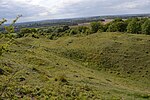Church of St Giles, Totternhoe
Church of England church buildings in BedfordshireGrade I listed churches in BedfordshireUse British English from February 2023

The Church of St Giles is a Grade I listed church in Totternhoe, Bedfordshire, England. It became a listed building on 3 February 1967. The church was built using stone from local quarries and has a fine exterior. Flint flushwork decoration is used in the gable of the chancel. Building began in the 14th century and was not completed until the 16th.
Excerpt from the Wikipedia article Church of St Giles, Totternhoe (License: CC BY-SA 3.0, Authors, Images).Church of St Giles, Totternhoe
Church Road,
Geographical coordinates (GPS) Address Nearby Places Show on map
Geographical coordinates (GPS)
| Latitude | Longitude |
|---|---|
| N 51.8778 ° | E -0.5656 ° |
Address
Church Road
LU6 1RJ
England, United Kingdom
Open on Google Maps







